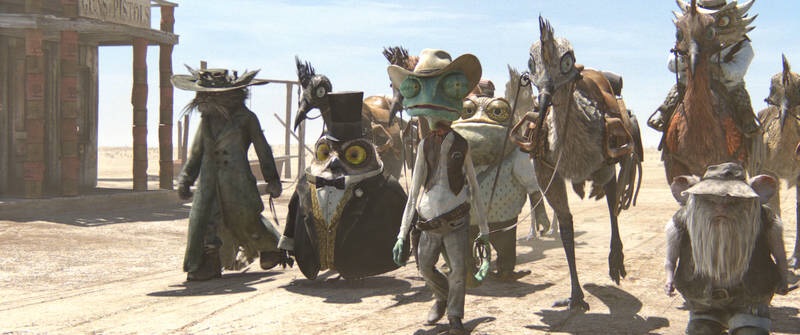the hero cannot exist in a vacuum
I've reviewed Rango before. Not specifically as a Western, of course. I described the film as "a little bit Road Warrior (at least in one sequence [others compare the sequence to Star Wars (and Rattlesnake Jake licking Beans' face is framed like Jabba licking Princess Leia)]), a couple parts Chinatown, and a whole lot of parts spaghetti western, though framed in the present day." In fact, aside from the chorus of mariachi owls, Rango is not a Western for a good 20 minutes.
Then, it has a habit of referencing other Westerns. Merrimac (Stephen Root) for example, sounds a lot like Colonel Stonehill, the horse trader in True Grit. The windmill squeaks like the one at the beginning of Once Upon a Time in the West. The hawk has a silver beak, like Lee Marvin in Cat Ballou. Rattlesnake Jake (Bill Nighy) is modeled on Angel Eyes (Lee Van Cleef) from The Good, the Bad & the Ugly (though his eyes actually resemble the eye of Sauron from The Lord of the Rings). It isn't all Western references, though. The water plot comes from Chinatown, and the mayor Tortoise John (Ned Beatty) is modeled on Noah Cross (John Huston) from that film.
Rango (Johnny Depp) himself is a little bit Clint Eastwood (or he pretends to be) by way of Don Knotts. He also calls Priscilla (Abigail Breslin) "little sister" like Rooster Cogburn called Mattie Ross in True Grit. The "possum" rides through Monument Valley and the music evokes the themes to numerous Westerns. There's even a minor character that is (apparently; just don't think about the actual setting of the film) a Civil War veteran, a bird with an arrow still through his head.

As for the plot--it is Wright's (1975) classical plot:
1. The hero enters a social group.
Rango not only comes from out of town, he virtually comes from another time.
2. The hero is unknown in the society.
They definitely don't know him.
3. The hero is revealed to have an exceptional ability.
Of course, he's lying about it--killing the seven Jenkins brothers with just one bullet--but then he inadvertently defeats the hawk with the townspeople watching.
4. The society recognizes a difference between themselves and the hero; the hero is given a special status.
Rango is made sheriff.
5. The society does not completely accept the hero.
When the "holy spigot" drops only mud, the town immediately blames the new guy in town.
6. There is a conflict of interests between the villains and the society.
Well, duh. Of course, it's not quite clear who the villains are right away (unless you've seen Chinatown.
7. The villains are stronger than the society; the society is weak.
And, they rule the town of Dirt like it's their playground.
8. There is a strong friendship or respect between the hero and a villain.
Again, this comes from Rango's lies. He claims that he and Rattlesnake Jake are brothers. He also plays golf with Tortoise John..
9. The villains threaten the society.
Again, duh.
10. The hero avoids involvement in the conflict.
Not too much. With the hawk, of course, he does try not to fight.
The Spirit of the West (Timothy Olyphant) is not only modeled on Clint Eastwood, Rango says they used to call him "the Man with No Name." His admonition to Rango--it's not about you, it's about them, encapsulates the heart of the classical plot. The outsider comes into town and saves the people. It's not his story. Not exactly.
11. The villains endanger a friend of the hero.
When Rango returns to Dirt (with a nice poncho added to his costume so he looks even more like the Man with No Name), Beans (Isla Fisher) is being threatened by Rattlesnake Jake because she won't make a deal with Tortoise John.
12. The hero fights the villains.
And, he's only got one bullet. The fight just happens to come as the clock strikes noon.
13. The hero defeats the villains.
They turn on each other.
14. The society is safe.
15. The society accepts the hero.
16. The hero loses or gives up his special status.
Great exchange between Priscilla and a background character. Priscilla explains why Rango is leaving. "Well, in order to satisfy the needs of the collective, the hero must abandon the self and solidify his image as an icon that will forever be remembered." The response: "So, it's the sunset shot."
Tortoise John, when he turns on Rattlesnake Jake, talks about Jake and Rango being legends. The legend is, of course, more powerful than the reality.
Comments
Post a Comment